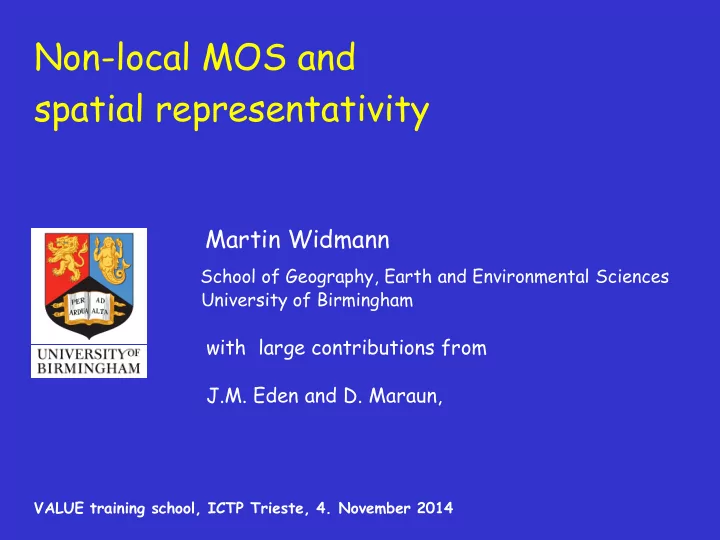

Non-local MOS and spatial representativity Martin Widmann School of Geography, Earth and Environmental Sciences University of Birmingham with large contributions from J.M. Eden and D. Maraun, VALUE training school, ICTP Trieste, 4. November 2014
Downscaling classification (used in VALUE COST action) 1. Dynamical Downscaling 1. Perfect Prog(nosis) (PP) 2.1 deterministic 2.2 probabilistic (PDFs but no time series) 2.3 stochastic, time series / weather generator 3. Model Output Statistics (MOS) 3.1 deterministic (this talk: pair-wise, non-local) 3.2 probabilistic 3.3 stochastic, timeseries / weather generator
Perfect Prog downscaling - estimating precip from pressure Coupled anomaly patterns (SVD) between DJF 1000 hPa geopotential height (NCEP) and daily preciptation geopot. height (Z1000) precipitation topography pair 1 pair 2 (Widmann and Bretherton, J. Climate 2000; Widmann et al., J. Climate, 2003)
Model Output Statistics - estimating true precipitation from simulated precipitation simulated precipitation observations (NCEP reanalysis) Coupled anomaly patterns (SVD) between DJF daily simulated (NCEP) and observed preciptation topography
Nudging of ECHAM5 towards ERA40 reanalysis Variables nudged towards ERA40 reanalysis (entire troposphere): Large-scale state - circulation (div, vort.) - temperature Parameterisations SST as in ERA40 Skill assessment and MOS based Simulated precipitation on parametrisation errors MODEL WORLD Validation REAL WORLD Observed precipitation (Eden et al. 2012)
PerfectProg and event-wise, non-local MOS downscaling We estimate precip for each observation gridcell using - PC-MLR and 1D-MCA (regression maps, Widmann, J. Clim. 2005) - PP and MOS MOS: ECHAM5 simulated precipitation is used as the predictor field. PP PP: geopotential height, temperature and humidity MOS at various pressure levels used as predictor fields.
One-dimensional MCA and CCA If one of the two fields is only 1-D, i.e. a time series: - CCA is identical to MLR (with or without PCA-prefiltering - MCA is identical to using time expansion coefficients of the regression map as predictor Although MLR maximises explained variance in the fitting period, it is not clear which method performs better on independent data. (i.e. in a cross-validation setting) PCA-prefiltering for CCA requires subjective decisions, MCA does not (Widmann, J. Climate, 2005)
Cross-validated skill of different MOS methods: correlations of estimated and observed monthly means (1958-2001) Local scaling 1D-MCA MLR; 2 PCs MLR; 10 PCs JAN JULY
Observed and MOS-estimated European mean precipitation (using cross validation) OBS Local scaling local scaling r = 0.777 RMSE = 3.86 r = 0.777 RMSE = 3.86 1D-MCA r = 0.746 RMSE = 3.75 MLR with 5 PCs r = 0.786 RMSE = 2.94 local scaling r = 0.600 RMSE = 5.17 1D-MCA r = 0.573 RMSE = 4.46 MLR with 5 PCs r = 0.569 RMSE = 4.01
Correlations of January precipitation from PP and MOS downscaling with observations Local scaling MLR; 10 PCs (Eden and Widmann, J. Climate, 2014)
Absolute precipitation 2080-2099 and relative change (raw and downscaled) Seasonal ¡precipitation ¡ ¡(A1B ¡SRES; ¡2080-‑2099) ¡ % ¡Difference ¡between ¡2080-‑2099 ¡and ¡1980-‑1999 ¡ Raw ¡ECHAM5 ¡ Downscaled ¡using ¡PC-‑MLR ¡ Raw ¡ECHAM5 ¡ Downscaled ¡using ¡PC-‑MLR ¡ DJF ¡ JJA ¡ mm ¡ % ¡
Spatial representativity in RCMs
Principal options for comparing spatial variability in simulations and observations - calculate characteristic measures one-point correlation maps - calculate links between simulated and observed variables (approach taken here)
Local correlations between observed and RCM-simulated precipitation Simulation: seasonal precipitation means RACMO2 (KNMI, 0.22 deg) driven by ERA40, 1961-2000 Observations: E-OBS DJF JJA (Maraun and Widmann, submitted)
Spatial representativity issues Scale mismatch - PDFs for area means are different from the PDFs for local variables. This can be addressed by PDF mapping. - area mean does not explain all of the local variance. This can be addressed by probabilistic MOS. Location representativity - the model grid cell that included the target location might not be the best predictor for several reasons * systematic bias in large-scale atmospheric circulation * unrealistic topography * small-scale processes linked to topography that are not captured by the local grid cell (e.g. local winds) This can be addressed by non-local MOS.
Assessment of location representativity (operational definition) In a perfect boundary setup the grid cell with the best location representativity is the one with the highest correlation with the local time series. Because of internally generated variability in RCMs we consider correlations for seasonal means.
Correlations between observed (at central grid box) and RCM-simulated precipitation Simulation: DJF precipitation means RACMO2 (KNMI, 0.22 deg) driven by ERA40 Observations: E-OBS
Time series, zonal cross section through central grid cell observed simulated
Non-local correlations between observed and RCM-simulated precipitation (best grid box Simulation: seasonal precipitation means RACMO2 (KNMI, 0.22 deg) driven by ERA40 Observations: E-OBS DJF JJA (Maraun and Widmann, submitted)
Difference between non-local and local correlations (DJF) direction difference Some systematic improvement over areas with complex topography Local grid cell is in some areas not location representative, which leads to low local correlations.
Difference between non-local and local correlations (DJF) direction difference No systematic improvement Low local correlations not due to local representativity problems
Change in trends using non-local grid cells Closer to observed trends Less close to observed trends JJA DJF
Summary In areas of complex topography the local model grid cells may not be representative for the local target variable. (even after a PDF mapping or probabilistic MOS) Pattern-based methods or using simulated predictors from nearby locations can improve downscaling performance.
Recommend
More recommend